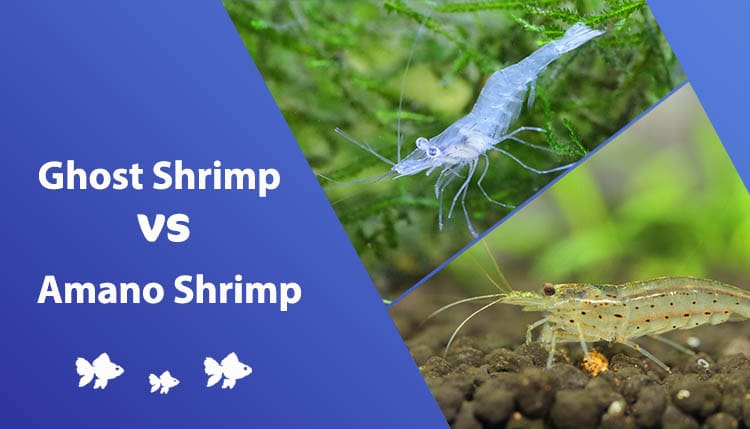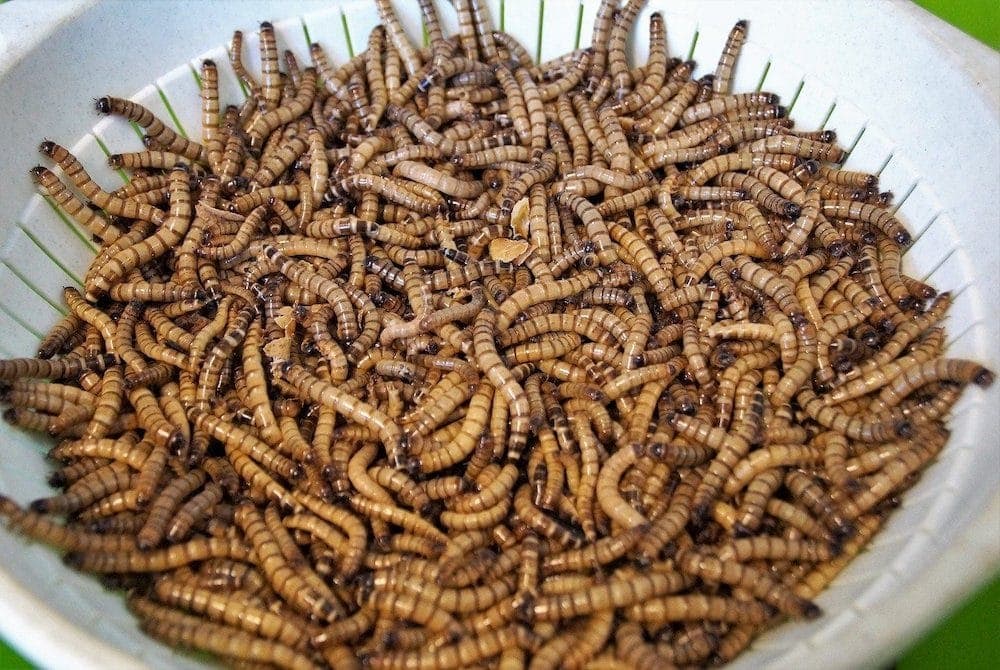10 Great Tank Mates for Bala Sharks: Compatibility Guide

Updated on
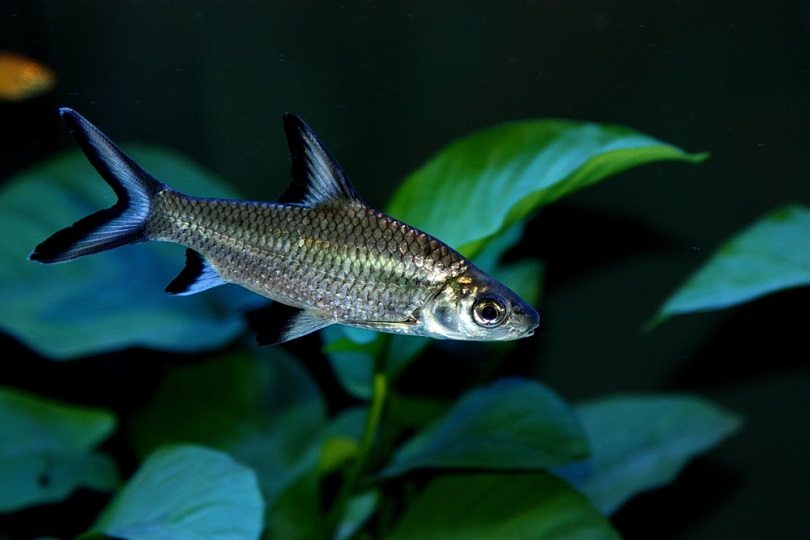
As a large aquarium fish, the Bala shark requires a lot of tank space, and this opens up the possibility of keeping these gentle giants with other fish.
As well as other Bala sharks, this species can do well when kept with others. Below, we have listed 10 of the best tank mates for your tank sharks. We’ve also included some of the species you should avoid keeping in the same tank. Let’s dive in!
The 10 Great Tank Mates for Bala Sharks
1. Angelfish
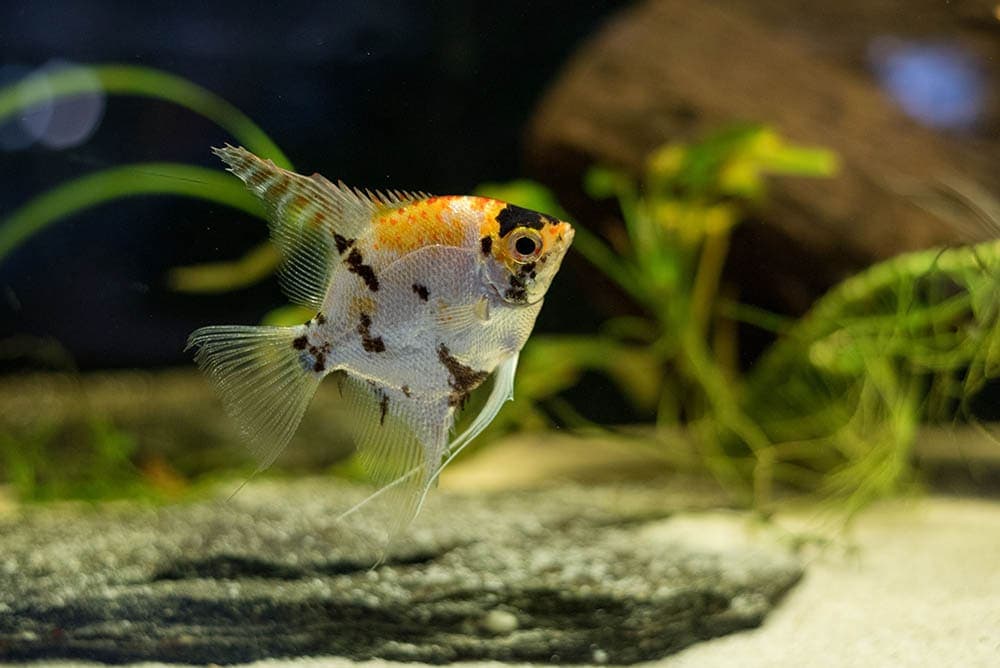
| Size: | 4–14 inches |
| Diet: | Omnivore |
| Minimum Tank Size: | 30 gallon |
| Care Level: | Easy |
| Temperament: | Semi-aggressive |
Angelfish are a type of cichlid from South America. Unlike other Cichlids, they do not tend to be aggressive, although they tend to be more aggressive during breeding and rearing.
Some Angelfish will eat small tank inhabitants, which isn’t a problem with the Bala shark. They can also be prone to having their fins nibbled, but the bala shark is not usually guilty of this kind of behavior. They thrive in the same water conditions as the shark and even the most common silver Angelfish will look striking in your aquarium.
2. Kissing Gourami
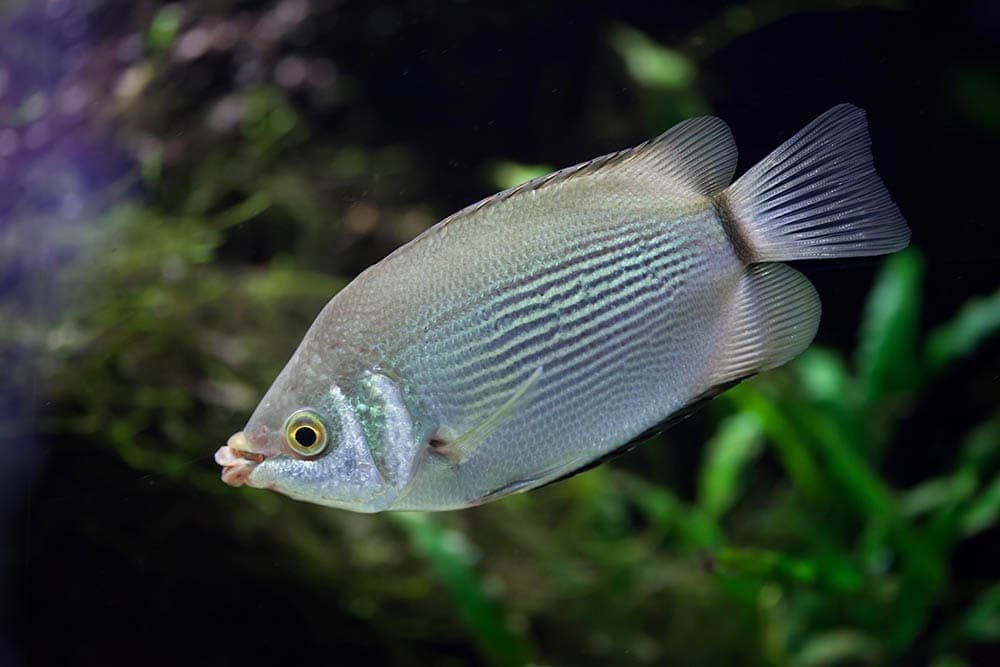
| Size: | 12–16 inches |
| Diet: | Omnivore |
| Minimum Tank Size: | 75 gallons |
| Care Level: | Easy |
| Temperament: | Semi-aggressive |
Often called kissing fish or kissers, Kissing Gouramis are medium-sized fish that come from Southeast Asia. They like warm water so will appreciate your setup, but you do need to be careful with the live plants that you stock because this species can and will eat plant matter.
The Kissing Gourami is considered semi-aggressive. It is usually peaceful and calm but may become aggressive if it is kept in less-than-ideal tank conditions.
3. Blood Parrot Cichlid
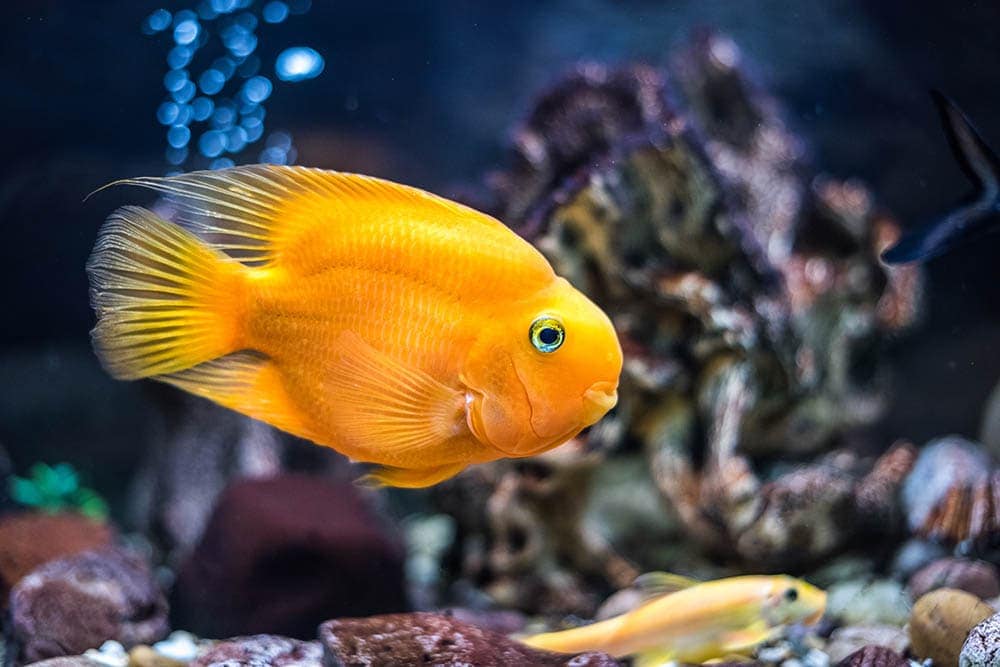
| Size: | 7–10 inches |
| Diet: | Omnivore |
| Minimum Tank Size: | 30 gallons |
| Care Level: | Intermediate |
| Temperament: | Semi-aggressive |
The Blood Parrot Cichlid is a recent hybrid of the Midas and Redhead Cichlid that has a beak-shaped mouth that does not fully close. This characteristic means that any signs of aggression, which are rare but possible in the species, are resolved by butting and bumping one another, which won’t pose a problem when the 8-inch cichlid comes up against a 14-inch Bala shark.
This species is considered to be moderately difficult to look after because it does produce a lot of waste. Regular water changes, coupled with a powerful filtration and pump system, are important.
- Related Read: 20 Types of Cichlids for Your Aquarium
4. Tetras

| Size: | 1–2 inches |
| Diet: | Omnivore |
| Minimum Tank Size: | 10 gallons |
| Care Level: | Easy |
| Temperament: | Peaceful |
The Tetra is another warm-water-loving fish, and this particular group of species flourishes when kept in a shoal of 10. The Tetra is a peaceful little fish that won’t cause any harm to the Bala. Its bright colors mean that the Tetra shows up especially well against a dark aquarium, although there is a great range of different species you can opt for, including those that grow a little larger and those that are easier to spot even against a light substrate.
5. Rainbowfish
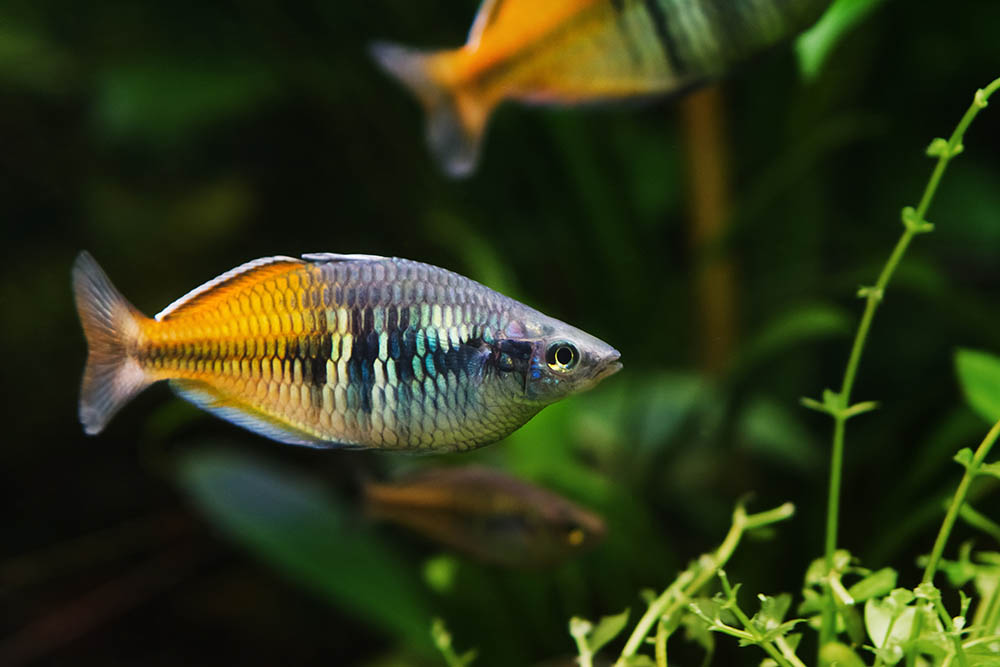
| Size: | 4–8 inches |
| Diet: | Omnivores |
| Minimum Tank Size: | 30 gallons |
| Care Level: | Easy |
| Temperament: | Peaceful |
The striking Rainbowfish is a peaceful fish that not only gets along with other fish but thrives in a well-stocked aquarium. It can live with Tetras, Rasboras, and some Cichlids, as well as the Bala shark.
Try to restrict your shoal to a single male, because two or more can lead to some aggression between them. But, other than that, this species of brightly colored fish is considered easy to maintain and will live well alongside your other tank inhabitants.
6. Common Pleco Fish
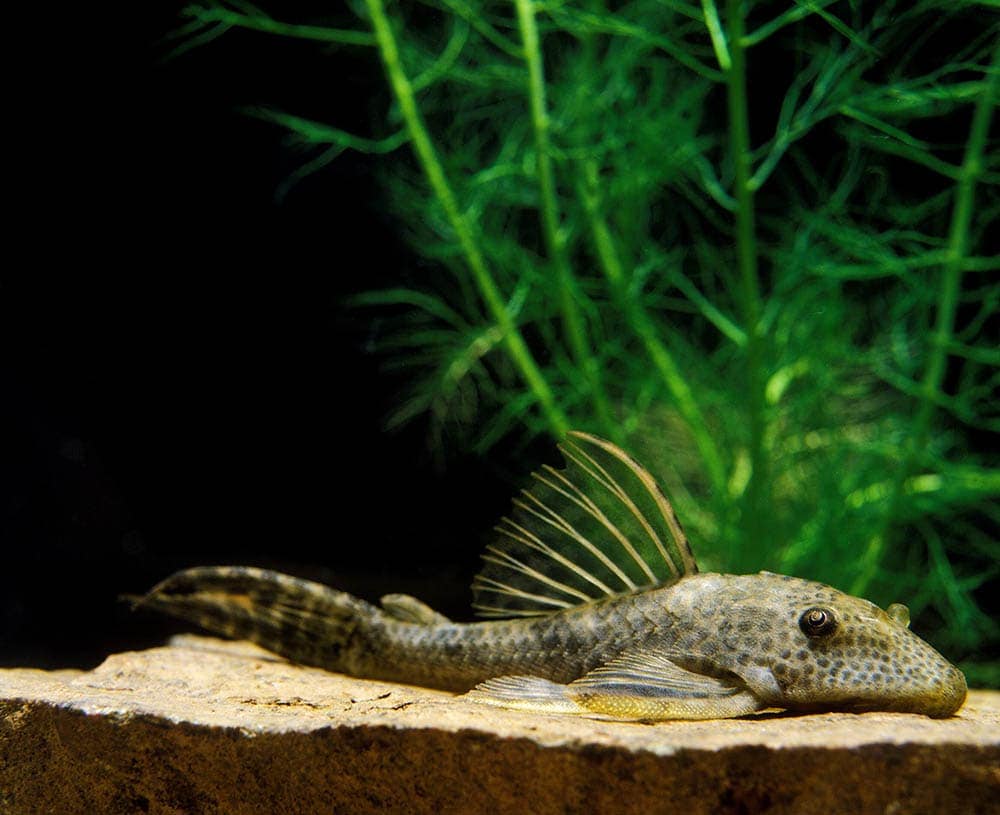
| Size: | 12–20 inches |
| Diet: | Omnivores |
| Minimum Tank Size: | 75 gallons |
| Care Level: | Easy |
| Temperament: | Semi-aggressive |
The common Pleco fish is known as the Suckermouth Catfish and is lovingly referred to as the “tank janitor.” They are armored catfish that feed primarily on the algae in an aquarium, although they also benefit from supplementation with some plant matter.
The pleco will spend the daytime in hiding but becomes highly active at night when it patrols the tank looking for algae. This species can become aggressive as it matures, so take some care when mixing it with other species.
7. Clown Loaches
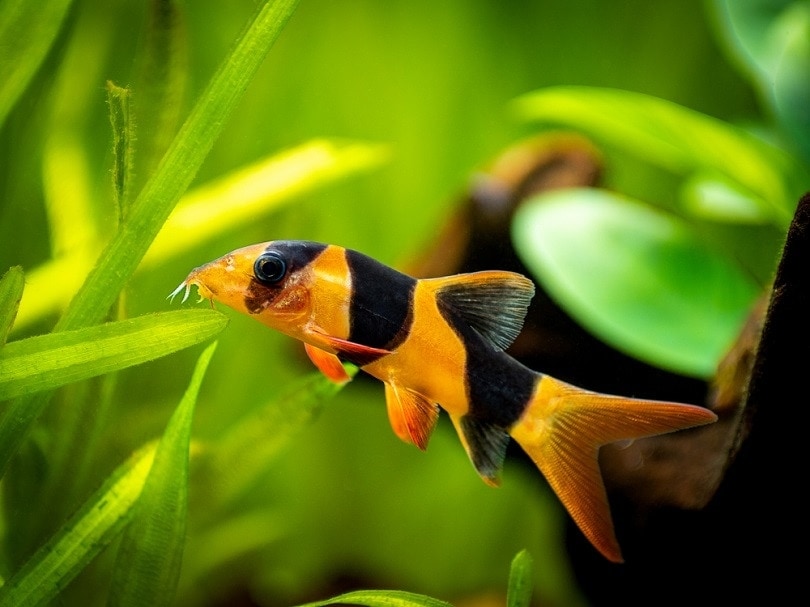
| Size: | 6–12 inches |
| Diet: | Omnivores |
| Minimum Tank Size: | 30 gallons each |
| Care Level: | Easy |
| Temperament: | Peaceful |
Clown loaches need to be kept in shoals of at least five, otherwise, they will be overly timid and will spend their time trying to hide. When kept in a decent size family, though, they are bright and colorful additions to a home aquarium.
These bottom-dwelling fish have long bodies that allow them to quickly dart through the water, which makes them entertaining to observe.
8. Tinfoil Barbs

| Size: | 10–14 inches |
| Diet: | Omnivore |
| Minimum Tank Size: | 55 gallons |
| Care Level: | Easy |
| Temperament: | Peaceful |
The Tinfoil Barb is renowned for being one of the easiest fish to care for, making them a popular first-time choice of aquarists. This docile species will get along with most other types of fish, but it does require a lot of space with a fully grown adult reaching 14 inches in size. They also require good filtration to keep waste to a minimum and to ensure that the barbs remain healthy and happy.
9. Rasbora
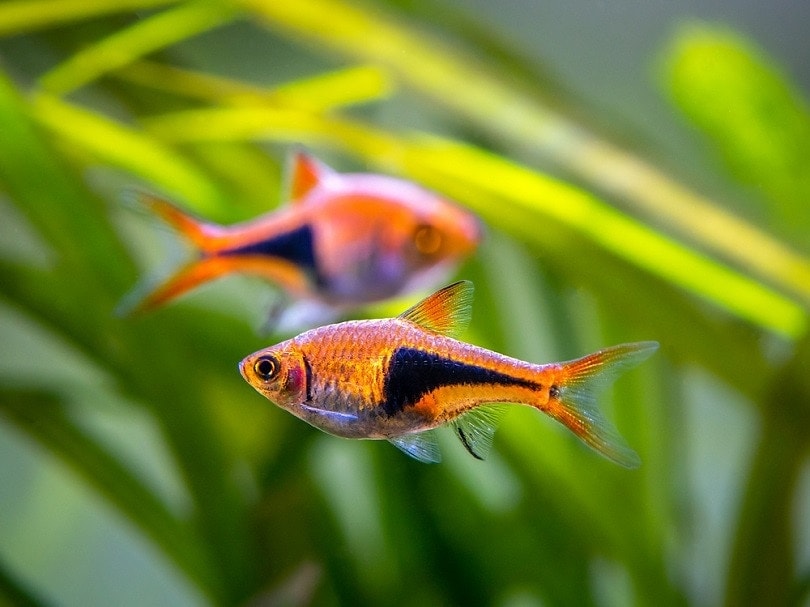
| Size: | 2–4 inches |
| Diet: | Carnivore |
| Minimum Tank Size: | 10 gallons |
| Care Level: | Easy |
| Temperament: | Peaceful |
The Rasbora is another relatively small fish that, like the Tetra, will look its best when kept in an aquarium with a dark substrate and plenty of vegetation. Because these fish live in streams, they need a slight current in the tank, which means that you will need a reasonably powerful pump system to meet their condition requirements.
Peaceful in nature, you can keep most rasbora species with other small fish, as well as with larger aquarium buddies.
10. Discus Fish

| Size: | 15–20 inches |
| Diet: | Carnivore |
| Minimum Tank Size: | 50 gallons |
| Care Level: | Moderate |
| Temperament: | Peaceful |
Discus fish are one of the more challenging fish to keep on this list. They require specific water conditions, which, thankfully, match the ideal conditions of the bala shark.
They cannot be kept alone, preferring a shoal of approximately five, and you will have to maintain a clean and clear tank to ensure healthy discus fish. However, they are very pretty and they live a peaceful life, so they won’t be the cause of any in-tank arguments.
- Related Read: 10 Best Tank Mates for Discus Fish
What Makes a Good Tank Mate for Bala Sharks?
The Bala shark is known as the gentle giant of the aquarium. It can grow to a large size but will not usually show signs of aggression towards other tank dwellers. They are also quite hardy, which means that smaller but aggressive fish will struggle to do any real harm.
With that said, it is better to find other peaceful fish, and they should thrive in the warm water conditions that the sharks prefer. Avoid keeping crustaceans like shrimps or snails, because the omnivorous shark is likely to feed on these.
Where Do Bala Sharks Prefer to Live in the Aquarium?
The Bala shark enjoys swimming and, as such, it is most often found around the middle of the tank level, rather than the top or bottom. They will eat food from the surface, replicating the insect and insect eggs that they would eat in the wild. They will also scavenge at the bottom of the tank while looking for algae and leftover food.
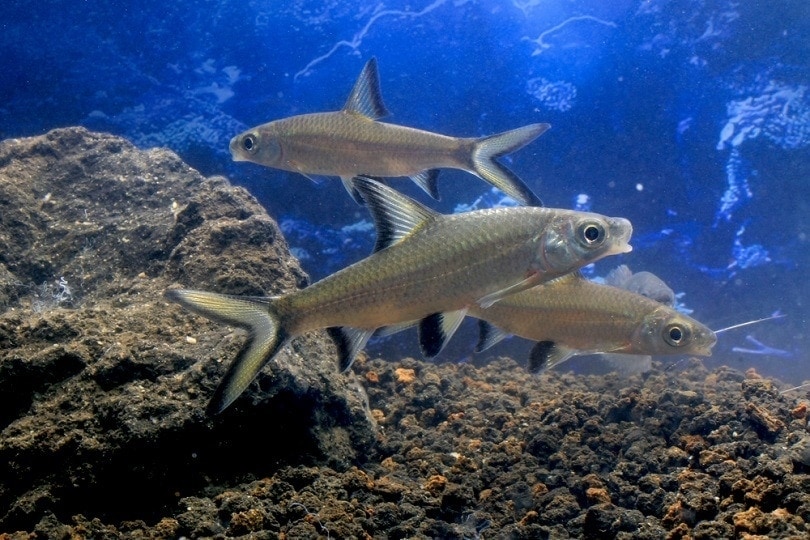
Water Parameters
This fish comes from fast-flowing rivers, which means that you need to match the strong flowing current by using a powerful pump system. Water temperature should be approximately 78°F and the pH as close to 7.0 as possible—between 6.5 and 8.0 at all times.
Ensure the tank has a lid because this species can jump. They prefer a combination of a medium and large substrate to mimic the pebbles at the bottom of rivers.
Size
The single biggest difficulty of keeping fish like the Bala shark is their size. Adults will grow to around 12 inches in length, which means that they require a minimum tank of 150 gallons. The more of them you keep, the larger the tank needs to be.
You should also take into account any other tank residents when calculating a suitable tank capacity.
Aggressive Behaviors
The Bala shark is not considered an aggressive species although it can eat smaller fish once it matures. They get along with other balas, too, and can be kept with other freshwater fish, typically with very few issues.
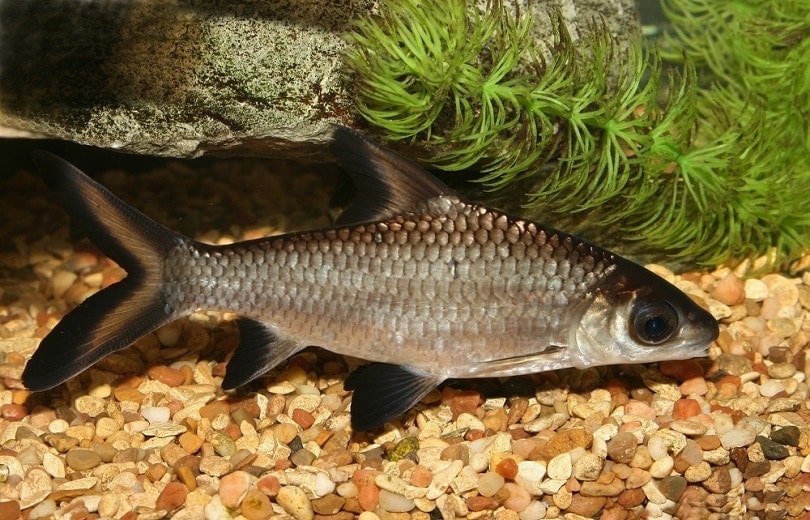
Top 3 Benefits of Having Tank Mates for Bala Sharks in Your Aquarium
- Shoaling Fish – The Bala shark is known as a shoaling fish, which means that it benefits from being part of a shoal. Typically, this means housing multiple Balas together, but it can mean incorporating different species of fish in the same aquarium.
- Tank Diversity – As striking as this fish is, it can get boring staring at the same fish swimming back and forth all day. By only keeping Bala shark, you miss out on the opportunity of being able to watch communities of tetras swimming together or experiencing plecos conducting their daily clean of the tank bottom.
- Less Aggression – Balas are described as gentle giants and are popular with home aquarists because they are peaceful fish, despite their size. However, a single Bala can get lonely and bored, leading to aggression. Keep two or more together and the chances of aggression are greatly reduced.
Conclusion
Although called the Bala shark, this fish has more in common with the common goldfish than with the shark. It is peaceful, lives in warm water, and is surprisingly easy to care for. The biggest obstacle to keeping this type of fish is its size, which means that you need a tank of at least 150 gallons to keep a decent shoal together.
As a largely peaceful fish, the Bala can eat any fish that is smaller than its mouth, but even this is not normally preceded by aggression. If you are concerned, choose only fish that are of a similar size to maintain tank harmony. Whatever species you choose must like the same warm, flowing water as the Bala or it will not thrive in your aquarium.
More Great Reads:
Featured Image Credit: Arunee Rodloy, Shutterstock



